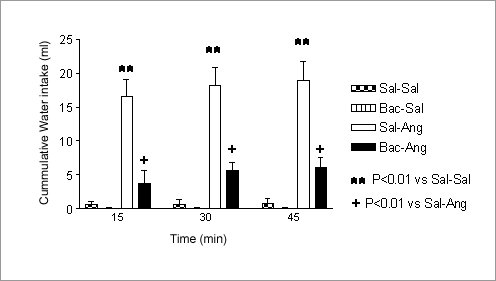Effects of baclofen on water intake induced in rats by central administration of angiotensin
It has previously been demonstrated that systemic administration of the GABA B receptor agonist baclofen (bac) inhibits drinking in rats by a possible central mode of action (Ebenezer et al., 1992, Houston et al., 2004). The present study was undertaken to investigate the effects of bac on drinking in rats induced by the central administration of angiotensin ll (ang), a potent dipsogen, which acts centrally as a neurotransmitter (Mendelsohn et al., 1990). Male Wistar rats (body weight: 330 – 360 g, n = 5) were implanted, under Equithesin anaesthesia, with cannulae directed towards the lateral ventricle for subsequent intracerebroventricular (icv) administration of drugs, as described previously (Ebenezer, 1990). The animals were allowed 7 days to recover from surgery before training sessions and experimental trials began. During experimental trials, the rats received each of the following treatments: saline (sal) followed by sal, bac (2 mg kg-1) followed by sal, sal followed by ang (10 mg), and bac (2 mg kg-1) followed by ang (10 mg). The first injection was given s.c. and the second icv (injection volume 5 μl); 15 min separated the two injections. The rats were presented with water immediately after the icv injection and water intake measured at intervals over 45 min. The results were analysed by ANOVA and post-hoc Dunnett’s test. The results are illustrated in Fig. 1. Angiotension elicited a drinking response in the rats that was most apparent during the first 15 min. Pretreatment with bac significantly (P<0.01) inhibited effects of centrally administrated ang on water intake.
Fig. 1. Effects of baclofen on angiotensin-induced drinking. Vert.lines rep. + s.e.m.
The results show that bac significantly attenuates the dipsogenic effect of ang. It has been proposed that ang containing afferents from the subfornical organ (SFO) extend to the medial preoptic nucleus (MePO), where the release of ang induces drinking (Lind et al., 1982). It is therefore possible that bac acts within the MePO to inhibit the effects of ang. Further studies are therefore warranted to investigate the role of GABA and GABA B receptors within this pathway to determine whether endogenous GABA plays a regulatory role in the control of water intake.
Ebenezer, I.S. (1990) NeuroReport, 1, 73 – 76 |
|


